Abstract
1. The effects of the carbonic anhydrase inhibitors, acetazolamide, ethoxzolamide and benzolamide on the ionic composition of parotid saliva were studied in anaesthetized sheep with access to the parotid blood vessels. 2. The inhibitors were infused directly into the arterial blood supply to the gland to give blood concentrations in the range 10(-5) to 10(-2) M. 3. Mean anionic concentrations at basal flow rate before inhibitor infusion were, bicarbonate 98 m-mole/l., phosphate 15 m-mole/l. and chloride 26 m-mole/l. In the presence of inhibitors, bicarbonate concentration fell by 11 m-mole/ml. and phosphate and chloride concentrations rose. Secreto-motor nerve stimulation increased bicarbonate concentration by 13 m-mole/l. before infusion of inhibitors and the concentrations of the other anions fell. The bicarbonate rise was abolished by the inhibitors and the fall in phosphate concentration was balanced by a rise in chloride concentration. 4. These effects show that only a small component of the bicarbonate ion transfer system in the sheep parotid gland is sensitive to these inhibitors. 5. The relationship of these findings to a new enzyme with carbonic anhydrase action isolated from the sheep's parotid gland is discussed.
Full text
PDF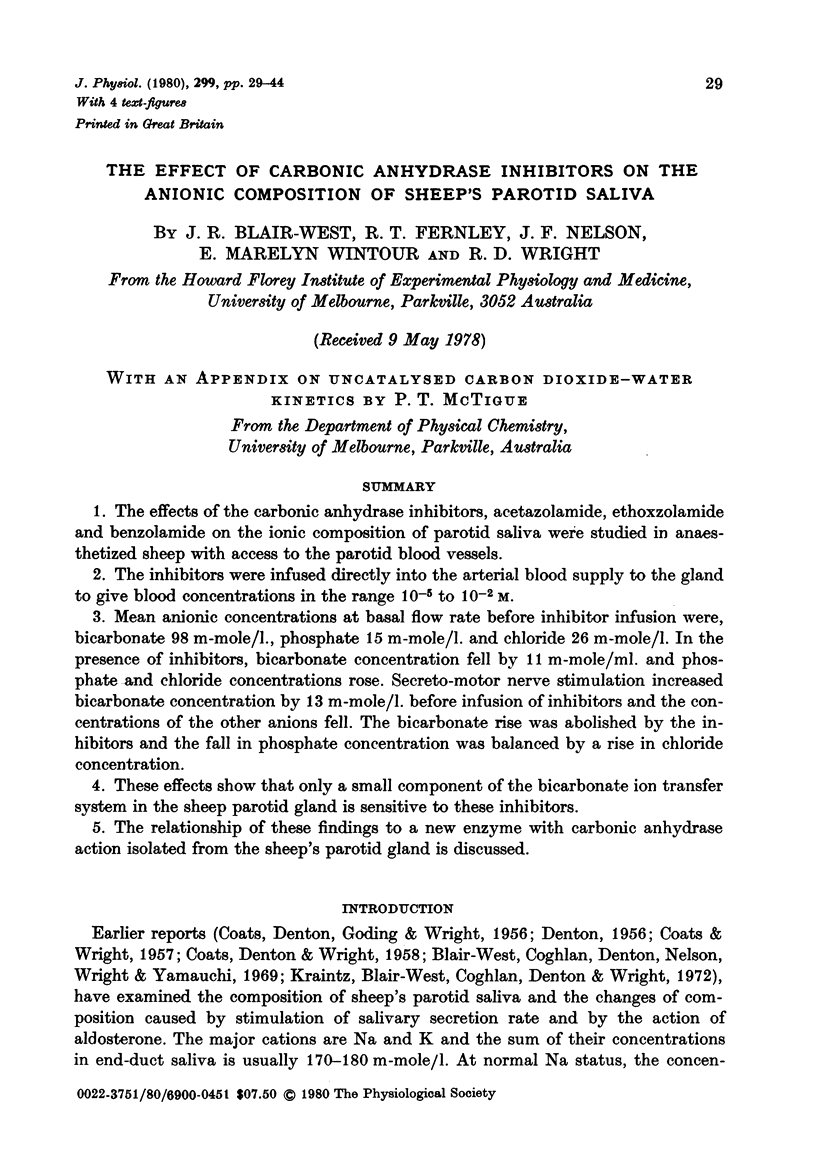
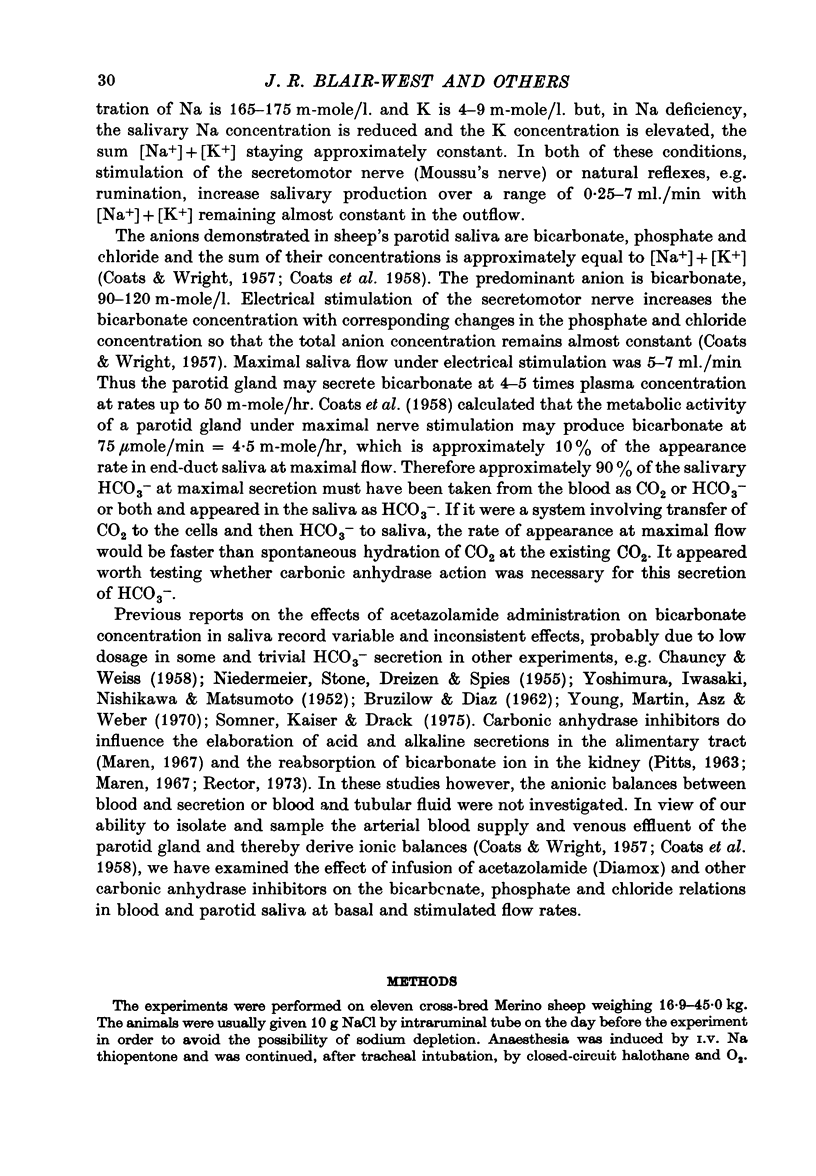

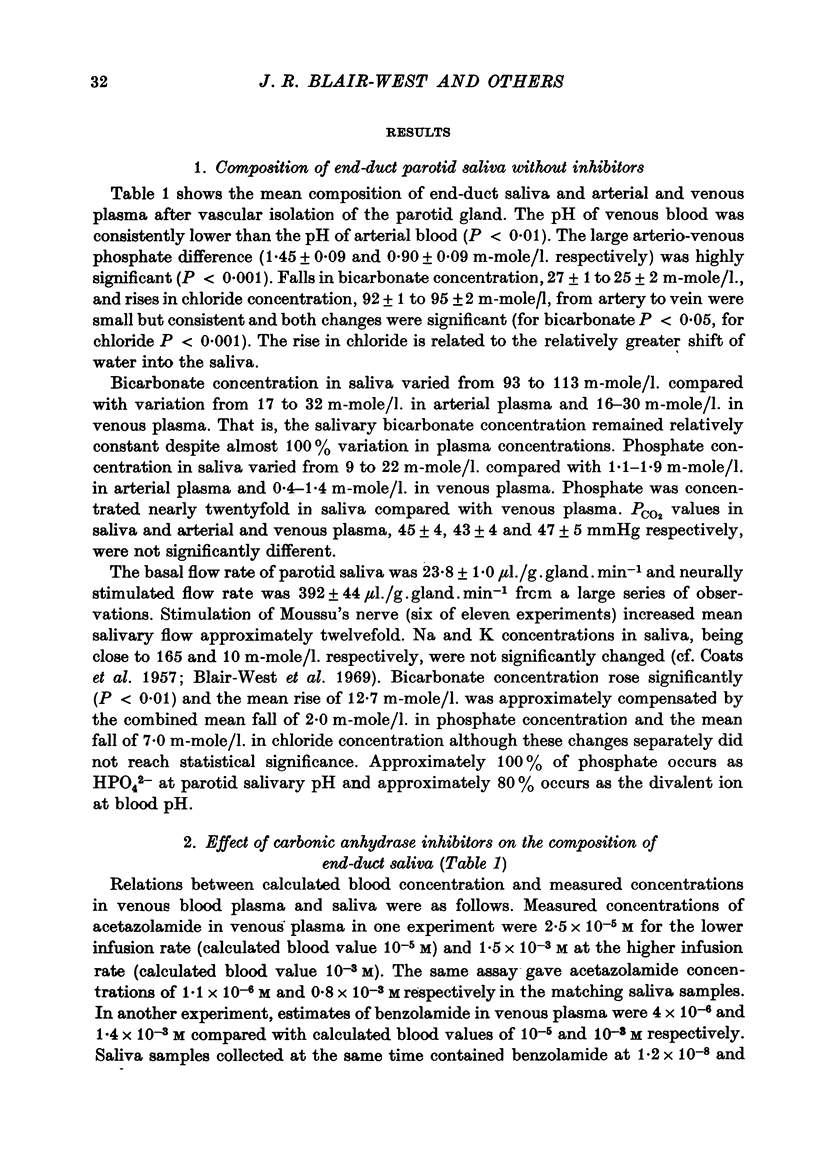
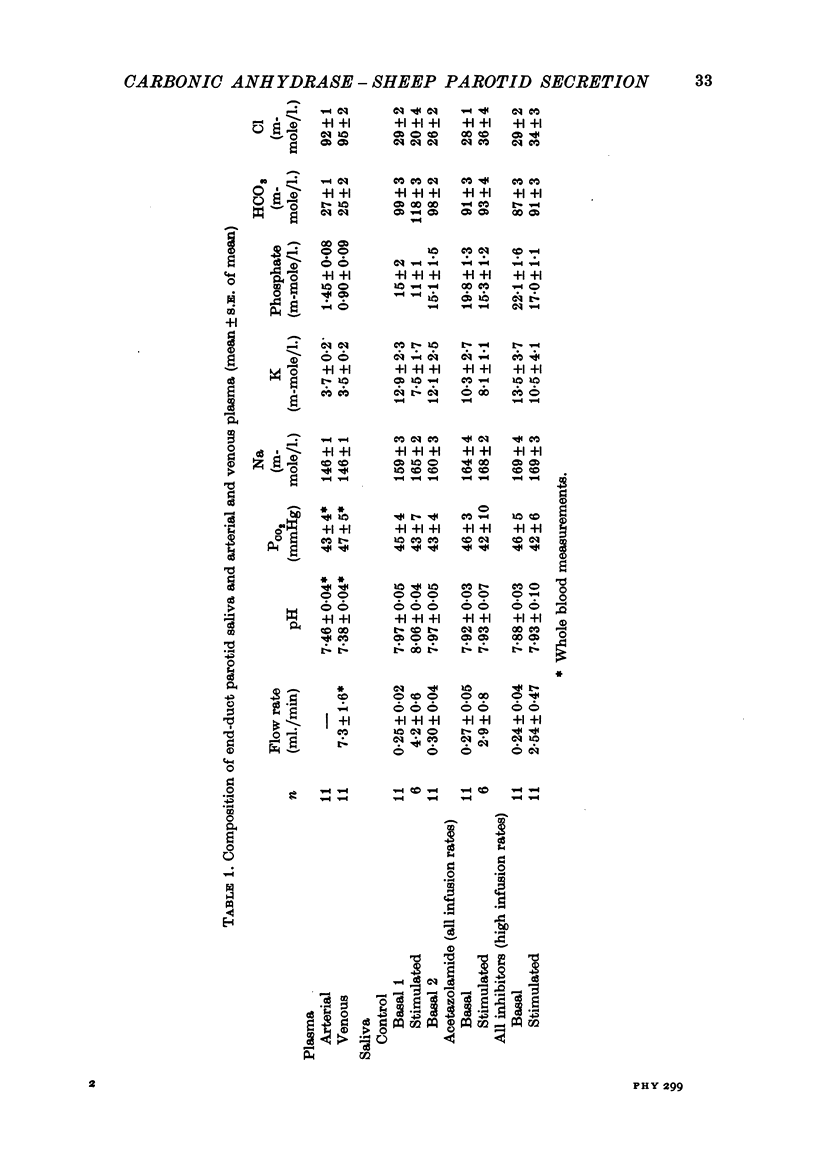
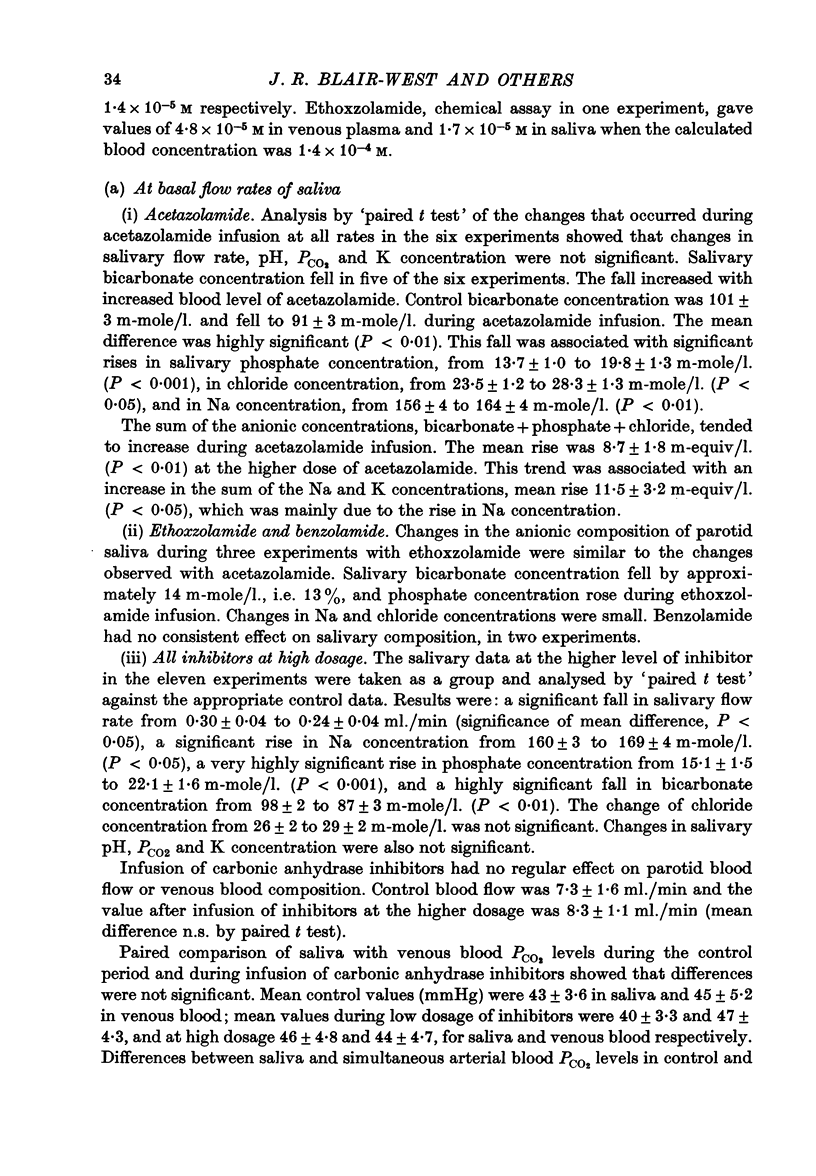
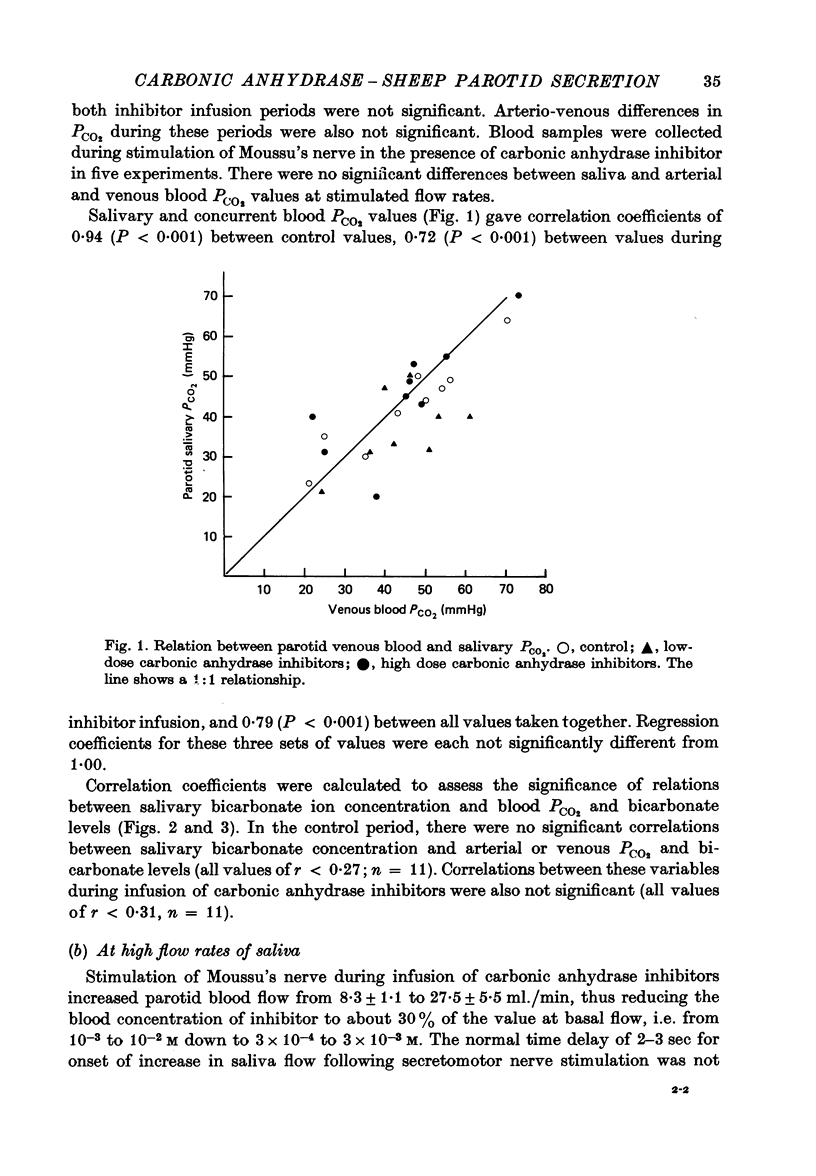

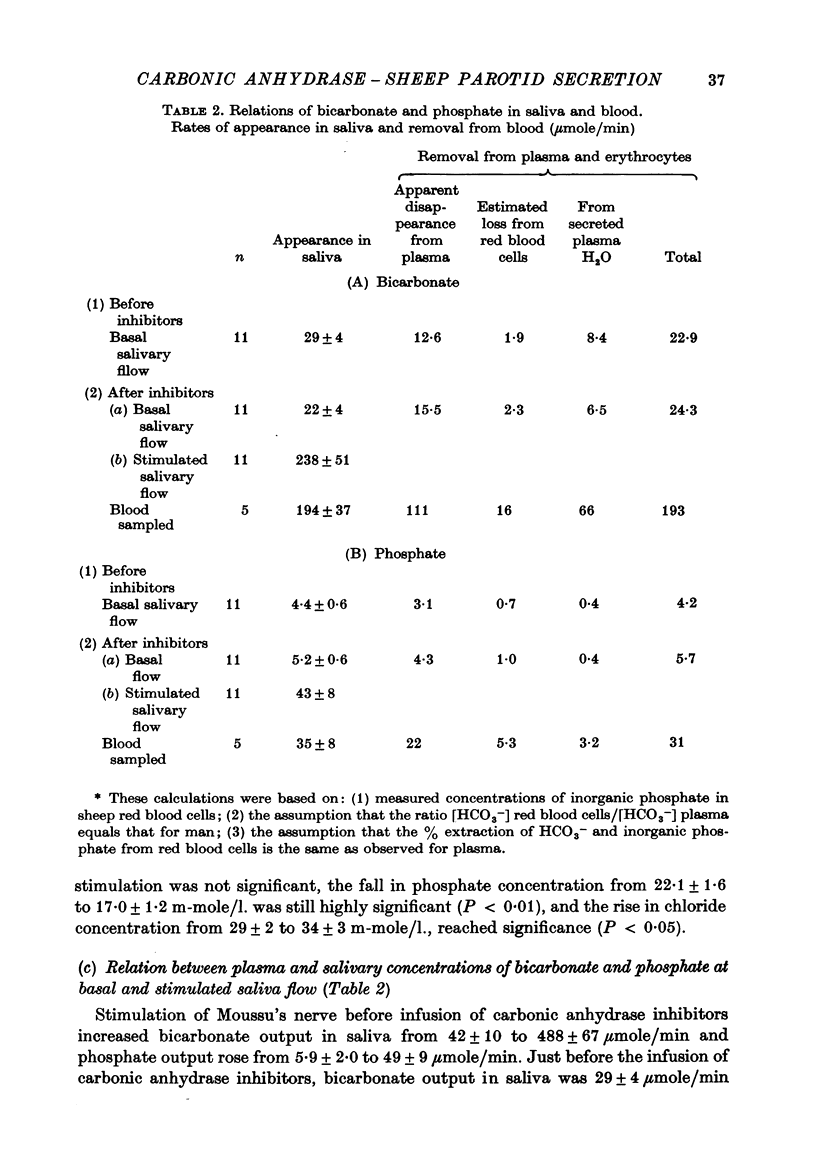
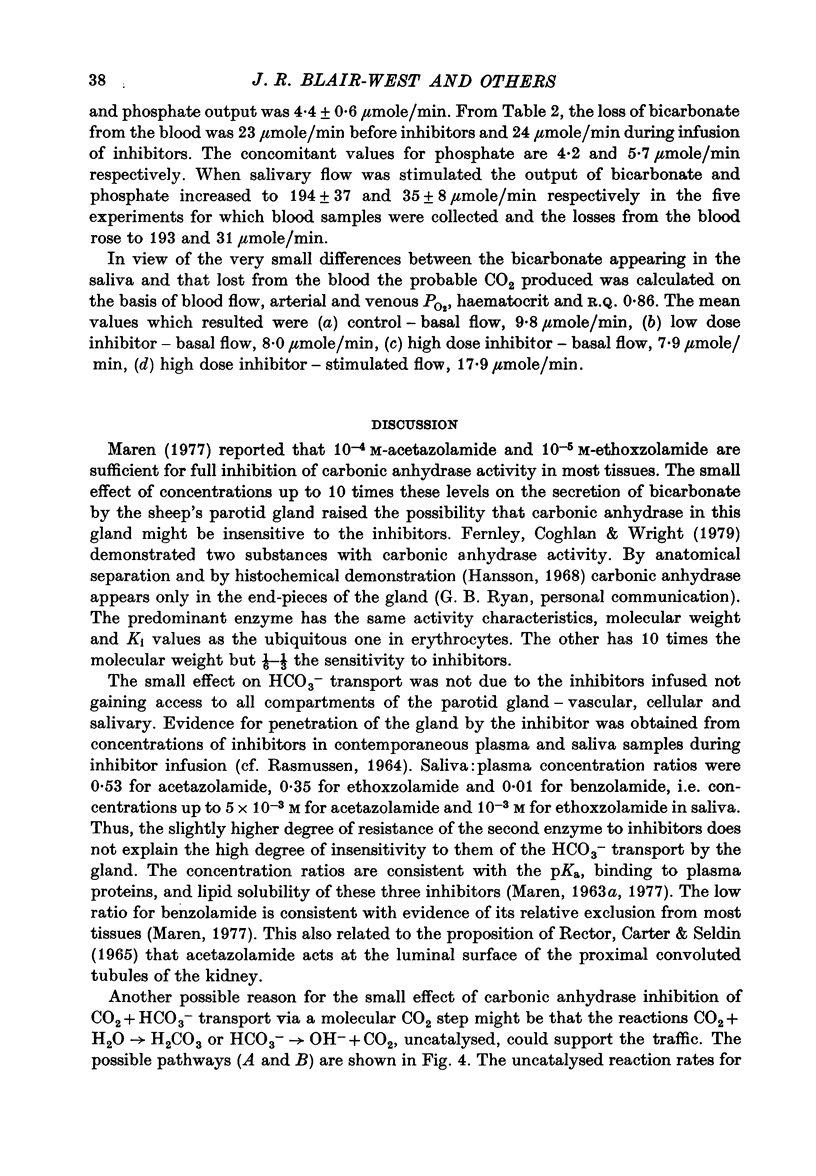
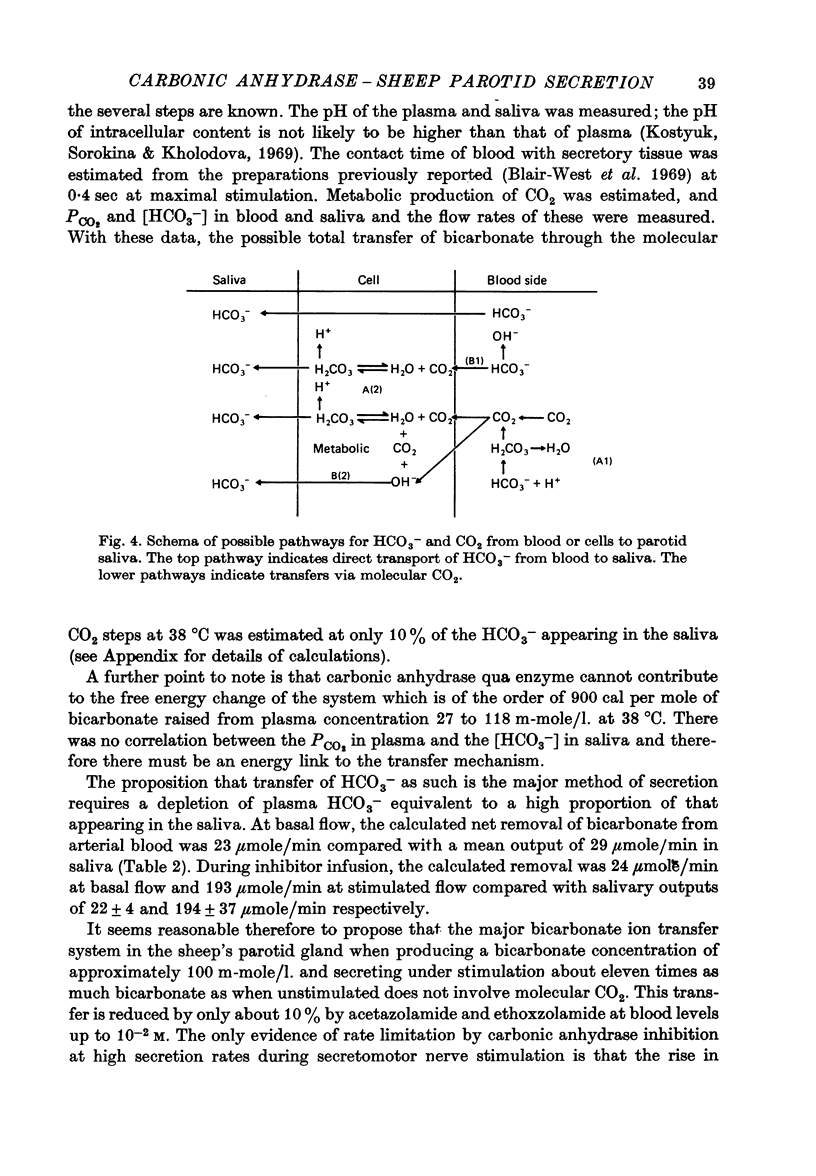
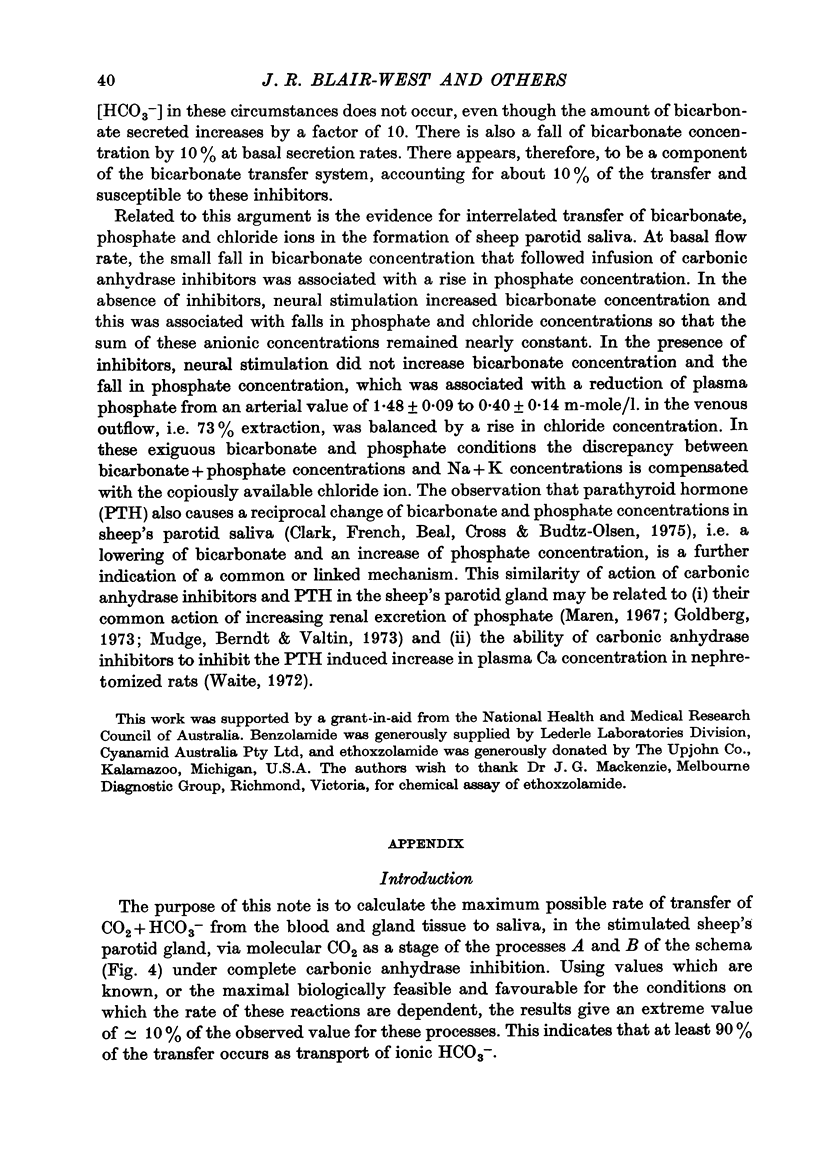
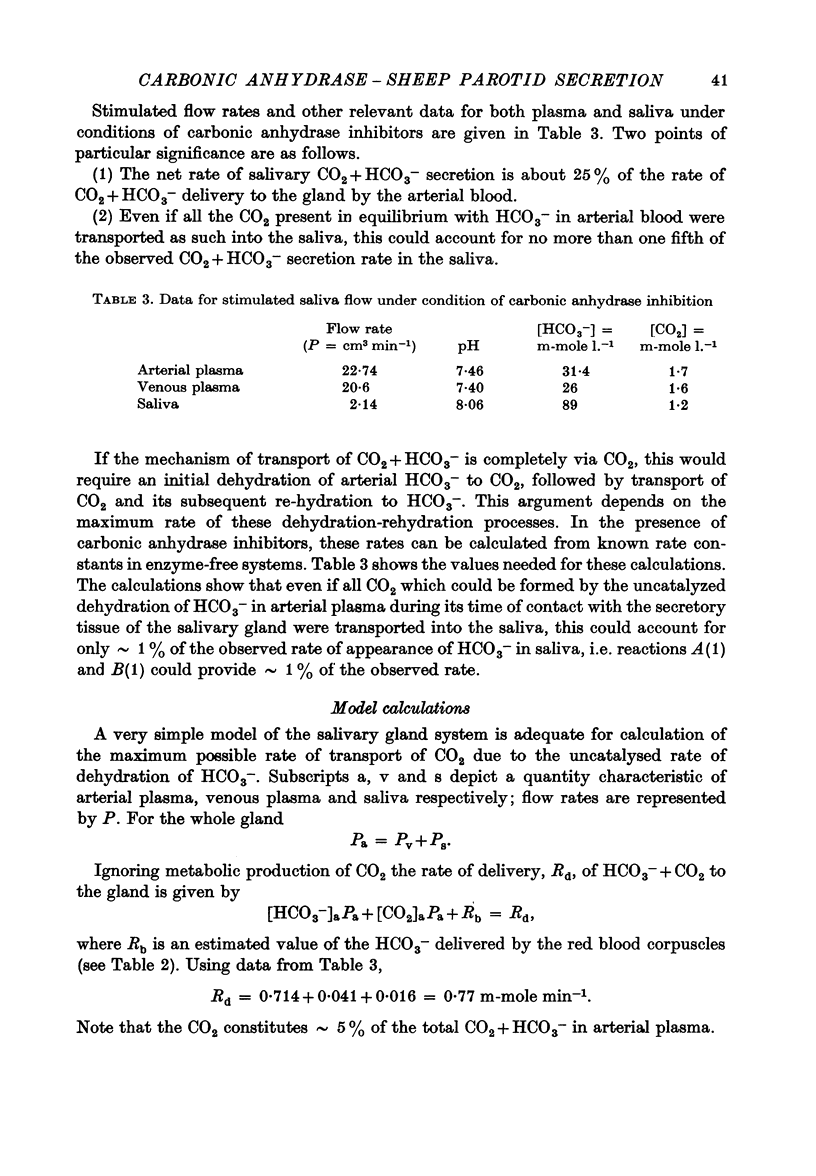
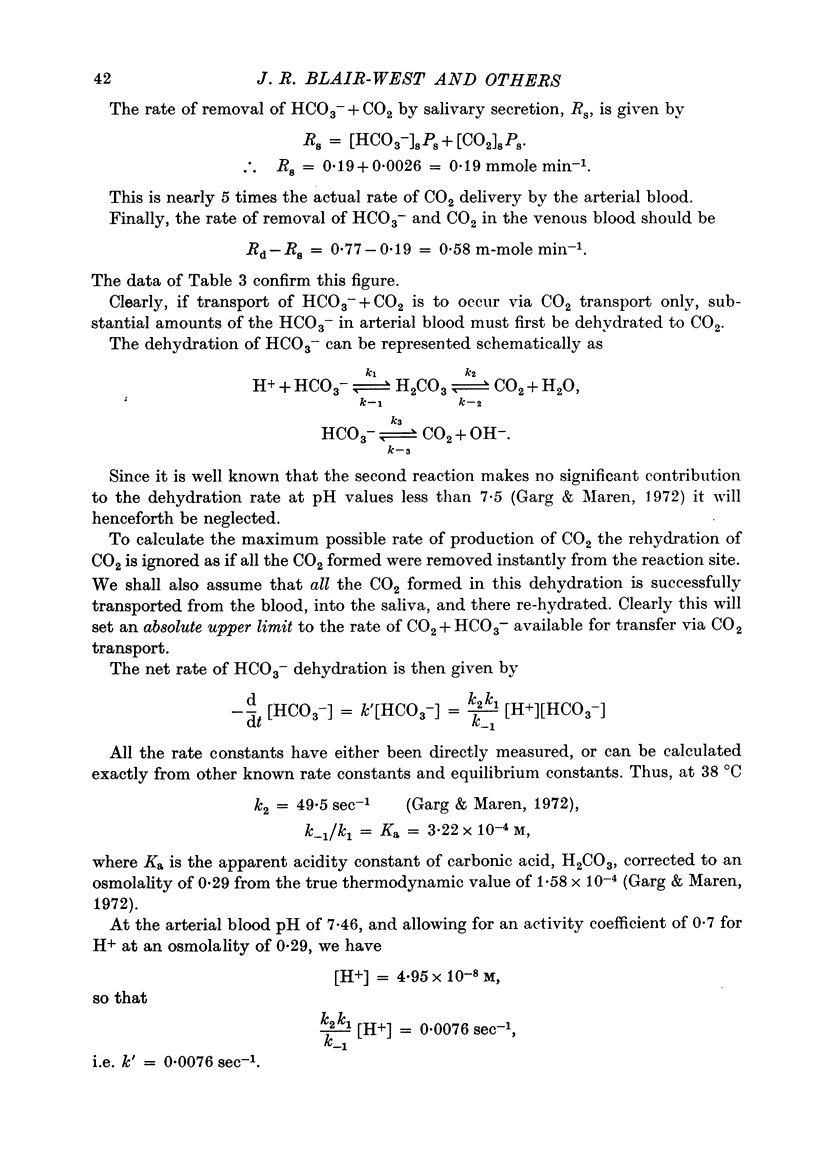

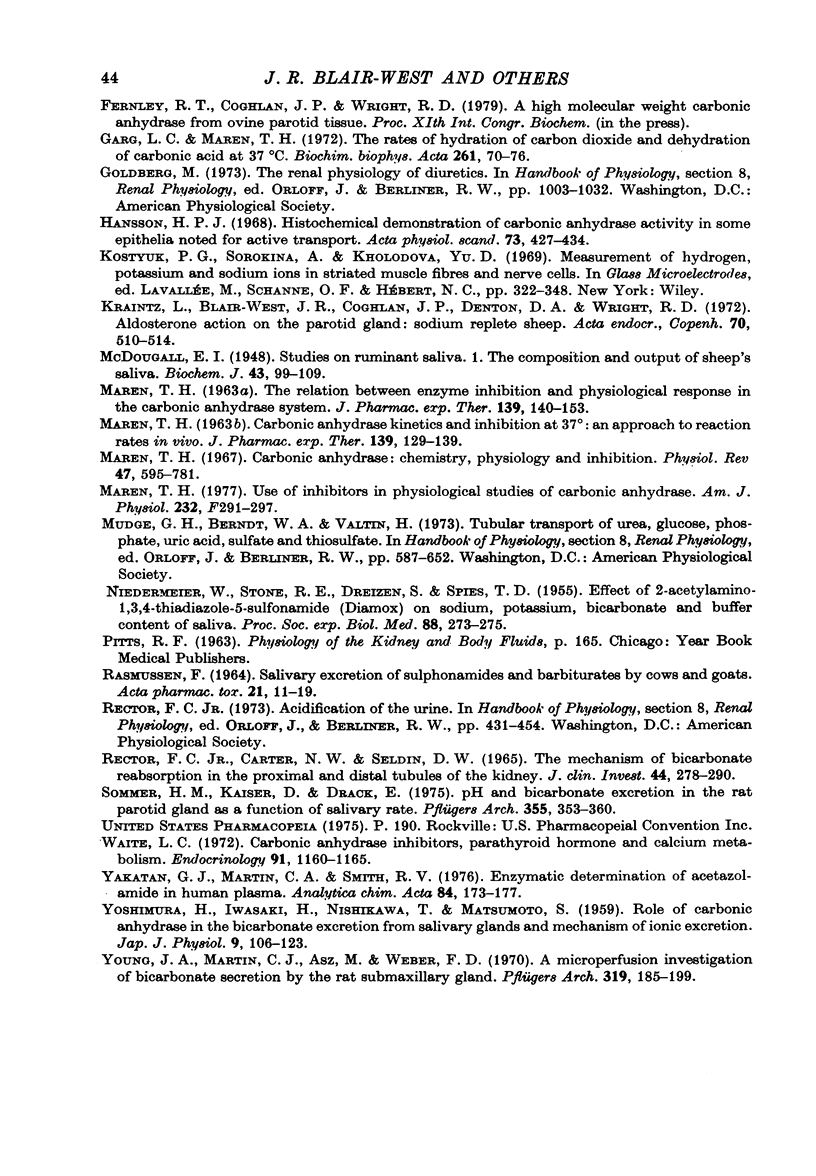
Selected References
These references are in PubMed. This may not be the complete list of references from this article.
- BRUSILOW S. W., DIAZ C. L. Effect of acetazolamide on dog parotid saliva. Am J Physiol. 1962 Jan;202:158–160. doi: 10.1152/ajplegacy.1962.202.1.158. [DOI] [PubMed] [Google Scholar]
- Blair-West J. R., Coghlan J. P., Denton D. A., Nelson J., Wright R. D., Yamauchi A. Ionic, histological and vascular factors in the reaction of the sheep's parotid to high and low mineralocorticoid status. J Physiol. 1969 Dec;205(3):563–579. doi: 10.1113/jphysiol.1969.sp008983. [DOI] [PMC free article] [PubMed] [Google Scholar]
- CHAUNCEY H. H., WEISS P. A. Composition of human saliva; parotid gland secretion: flow rate, pH and inorganic composition after oral administration of a carbonic anhydrase inhibitor. Arch Int Pharmacodyn Ther. 1958 Jan 1;113(3-4):377–383. [PubMed] [Google Scholar]
- COATS D. A., DENTON D. A., GODING J. R., WRIGHT R. D. Secretion by the parotid gland of the sheep. J Physiol. 1956 Jan 27;131(1):13–31. doi: 10.1113/jphysiol.1956.sp005441. [DOI] [PMC free article] [PubMed] [Google Scholar]
- COATS D. A., DENTON D. A., WRIGHT R. D. The ionic balances and transferences of the sheep's parotid gland during maximal stimulation. J Physiol. 1958 Nov 10;144(1):108–122. doi: 10.1113/jphysiol.1958.sp006089. [DOI] [PMC free article] [PubMed] [Google Scholar]
- COATS D. A., WRIGHT R. D. Secretion by the parotid gland of the sheep: the relationship between salivary flow and composition. J Physiol. 1957 Mar 11;135(3):611–622. doi: 10.1113/jphysiol.1957.sp005734. [DOI] [PMC free article] [PubMed] [Google Scholar]
- Clark R. C., French T. J., Beal A. M., Cross R. B., Budtz-Olsen O. E. The acute effects of intravenous infusion of parathyroid hormone on urine, plasma and saliva in the sheep. Q J Exp Physiol Cogn Med Sci. 1975 Apr;60(2):95–106. doi: 10.1113/expphysiol.1975.sp002307. [DOI] [PubMed] [Google Scholar]
- DENTON D. A. The effect of Na+ depletion on the Na+ :K+ ratio of the parotid saliva of the sheep. J Physiol. 1956 Mar 28;131(3):516–525. doi: 10.1113/jphysiol.1956.sp005479. [DOI] [PMC free article] [PubMed] [Google Scholar]
- Garg L. C., Maren T. H. The rates of hydration of carbon dioxide and dehydration of carbonic acid at 37 degrees. Biochim Biophys Acta. 1972 Jan 28;261(1):70–76. doi: 10.1016/0304-4165(72)90315-7. [DOI] [PubMed] [Google Scholar]
- Hansson H. P. Histochemical demonstration of carbonic anhydrase activity in some epithelia noted for active transport. Acta Physiol Scand. 1968 Aug;73(4):427–434. doi: 10.1111/j.1365-201x.1968.tb10882.x. [DOI] [PubMed] [Google Scholar]
- Kraintz L., Blair-West J. R., Coghlan J. P., Denton D. A., Wright R. D. Aldosterone action on the parotid gland: sodium replete sheep. Acta Endocrinol (Copenh) 1972 Jul;70(3):510–514. doi: 10.1530/acta.0.0700510. [DOI] [PubMed] [Google Scholar]
- MAREN T. H. Carbonic anhydrase kinetics and inhibition at 37 degrees: an approach to reaction rates in vivo. J Pharmacol Exp Ther. 1963 Feb;139:129–139. [PubMed] [Google Scholar]
- MAREN T. H. The relation between enzyme inhibition and physiological response in the carbonic anhydrase system. J Pharmacol Exp Ther. 1963 Feb;139:140–153. [PubMed] [Google Scholar]
- Maren T. H. Carbonic anhydrase: chemistry, physiology, and inhibition. Physiol Rev. 1967 Oct;47(4):595–781. doi: 10.1152/physrev.1967.47.4.595. [DOI] [PubMed] [Google Scholar]
- Maren T. H. Use of inhibitors in physiological studies of carbonic anhydrase. Am J Physiol. 1977 Apr;232(4):F291–F297. doi: 10.1152/ajprenal.1977.232.4.F291. [DOI] [PubMed] [Google Scholar]
- McDougall E. I. Studies on ruminant saliva. 1. The composition and output of sheep's saliva. Biochem J. 1948;43(1):99–109. [PMC free article] [PubMed] [Google Scholar]
- NIEDERMEIER W., STONE R. E., DREIZEN S., SPIES T. D. Effect of 2-acetylamino-1,3,4-thiadiazole-5-sulfonamide (diamox) on sodium, potassium, bicarbonate and buffer content of saliva. Proc Soc Exp Biol Med. 1955 Feb;88(2):273–275. doi: 10.3181/00379727-88-21561. [DOI] [PubMed] [Google Scholar]
- RASMUSSEN F. SALIVARY EXCRETION OF SULPHONAMIDES AND BARBITURATES BY COWS AND GOATS. Acta Pharmacol Toxicol (Copenh) 1964;21:11–19. doi: 10.1111/j.1600-0773.1964.tb01763.x. [DOI] [PubMed] [Google Scholar]
- RECTOR F. C., Jr, CARTER N. W., SELDIN D. W. THE MECHANISM OF BICARBONATE REABSORPTION IN THE PROXIMAL AND DISTAL TUBULES OF THE KIDNEY. J Clin Invest. 1965 Feb;44:278–290. doi: 10.1172/JCI105142. [DOI] [PMC free article] [PubMed] [Google Scholar]
- Sommer H. M., Kaiser D., Drack E. pH and bicarbonate excretion in the rat parotid gland as a function of salivary rate. Pflugers Arch. 1975 Apr 2;355(4):353–360. doi: 10.1007/BF00579856. [DOI] [PubMed] [Google Scholar]
- Waite L. C. Carbonic anhydrase inhibitors, parathyroid hormone and calcium metabolism. Endocrinology. 1972 Nov;91(5):1160–1165. doi: 10.1210/endo-91-5-1160. [DOI] [PubMed] [Google Scholar]
- YOSHIMURA H., IWASAKI H., NISHIKAWA T., MATSUMOTO S. Role of carbonic anhydrase in the bicarbonate excretion from salivary glands and mechanism of ionic excretion. Jpn J Physiol. 1959 Mar 25;9(1):106–123. doi: 10.2170/jjphysiol.9.106. [DOI] [PubMed] [Google Scholar]
- Yakatan G. J., Martin C. A., Smith R. V. Enzymatic determination of acetazolamide in human plasma. Anal Chim Acta. 1976 Jun;84(1):173–177. doi: 10.1016/S0003-2670(01)82852-X. [DOI] [PubMed] [Google Scholar]
- Young J. A., Martin C. J., Asz M., Weber F. D. A microperfusion investigation of bicarbonate secretion by the rat submaxillary gland. The action of a parasumpathomimetic drug on electrolyte transport. Pflugers Arch. 1970;319(3):185–199. doi: 10.1007/BF00586449. [DOI] [PubMed] [Google Scholar]


